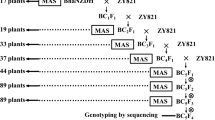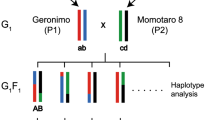Abstract
The feasibility of constructing an overlapping part-chromosome substitution library between the Landsberg erecta (Ler) and Columbia (Col ) ecotypes of Arabidopsis thaliana was investigated using computer simulations. Such a library can be used effectively in the fine mapping of quantitative trait loci (QTLs) in this species, with donor tracts of Col inserted into the recurrent background of Ler and vice versa. The study was based on the known RFLP profiles of Ler and Col ecotypes, and of some selected recombinant inbred lines (RILs) that have already been extracted from their cross by self pollination. It was shown that homozygous substitution lines can be produced for a large segment of the genome (>80%) by crossing just 11 RILs with their respective recurrent/recipient parents and selecting the desired recombinants from the F2 or Bc1 generation or their selfed progenies. In the case of four RILs, however, at least two rounds of backcrossing were deemed necessary to remove the unwanted donor tracts from the background genotype prior to selfing/selection. The simulations also provided valuable information on the scale of the breeding programme and show that a resource of up to 59 substitutions can be produced within a short period of 4-5 generations.
Similar content being viewed by others
References
Bell J. and Ecker J. R. 1994. Assignment of 30 microsatellite loci to the linkage map of Arabidopsis. Genomics 19: 137–144.
Breese E. L. and Mather K. 1957. The organisation of polygenic activity within a chromosome in Drosophila. I. Hair characters. Heredity 11: 373–395.
Breese E. L. and Mather 1960. The organisation of polygenic ac-tivity within a chromosome in Drosophila. II. Viability. Heredity 14: 375–399.
Darvasi A., Weinrerb A., Minke V., Weller J. and Soller M. 1993. Detecting marker-QTL linkage and estimating QTL gene effect and map location using a saturated genetic map. Genetics 134: 943–951.
Eshad Y. and Zamir D. 1994. Introgression from Lycopersicon pennellii can improve the soluble solids yield of tomato hybrids. Theor. Appl. Genet. 88: 891–897.
Ganal M. W., Young N. D. and Tanksley S. D. 1989. Pulsed field gel electrophoresis and physical mapping of large DNA fragments in the Tm-2a region of chromosome 9 in tomato. Mol. Genet. 215: 395–400.
Haley C. S. and Knott S. A. 1992. A simple regression method for mapping quantitative trait loci in line crosses using flanking markers. Heredity 69: 315–324.
Howell P. M., Marshall D. F. and Lydiate D. J. 1996. Towards devel-oping intervarietal substitution lines in Brassica napus using marker assisted selection. Genome 39: 348–358.
Hyne V., Kearsey M. J., Pike D. J. and Snape J. W. 1995. QTL analysis: unreliability and bias in estimation procedures. Mol. Breed. 1: 273–282.
Jansen R. C. and Stam P. 1994. High resolution of quantitative traits into multiple loci via interval mapping. Genetics 136: 1447–1485.
Kearsey M. J. and Hyne V. 1994. QTL analysis: A simple marker regression approach. Theor. Appl. Genet. 89: 698–702.
Kearsey M. J. and Pooni H. S. 1996. The genetical analysis of quan-titative traits. Chapman and Hall, London, UK.
Koester R. P., Sisco P. H. and Stuber C. W. 1993. Identification of quantitative trait loci controlling days to flowering and plant height in two near isogenic lines of maize. Crop. Sci. 33: 1209–1216.
Konieczny A. and Ausubel F. M. 1993. A procedure for mapping Arabidopsis mutations using co-dominant ecotype specific PCR based markers. Plant J. 4: 403–410.
Koumproglou R., Wilkes T. W., Townson P., Wang X. Y., Beynon J., Pooni H. S., Newbury H. J. and Kearsey M. J. 2002. STAIRS: a new genetic resource for functional genomic studies of Arabi-dopsis. Plant J. 31(3): 355–364.
Lander E. S. and Botstein D. 1989. Mapping Mendelian factors un-derlying quantitative traits using RFLP linkage maps. Genetics 121: 185–199.
Lister C. and Dean C. 1993. Recombinant inbred lines for map-ping RFLP and phenotypic markers in Arabidopsis thaliana. Plant J. 4: 745–750.
Meyerowitz E. M. 1994. Arabidopsis. Cold Spring Harbor Labora-tory Press. pp. 31–36.
Nadeau J. H., Singer J. B., Matin A. and Lander E. S. 2000. Analys-ing complex genetic traits with chromosome substitution strains. Nature Genetics. 24: 221–225.
Paterson A. M., Lander E. S., Hewitt J. D., Paterson S., Lincoln S. E. and Tanksley S. D. 1990. Fine mapping of quantitative trait loci using selected overlapping recombinant chromosomes in an in-terspecific cross of tomato. Genetics. 124: 735–742.
Press W. H., Flannery B. P., Teukolosky S. A. and Vetterling W. T. 1987. Numerical recipes: the art of scientific computing. Cambridge University Press, New York, USA.
Rae A. M., Howell E. C. and Kearsey M. J. 1999. More QTL for flowering time revealed by substitution lines in Brassica olera-cea. Heredity 83: 586–96.
Ramsay L. D., Jennings D. E., Bohuon E. J. R., Arthur A. E., Lydiate D. J., Kearsey M. J. and Marshall D. F. 1996. The construction of a substitution library of recombinant backcross lines in Brassica oleracea for the precision mapping of quantitative trait loci (TL). Genome. 39: 558–567.
Tanksley S. D. 1993. Mapping polygenes. Annu Rev Genet. 27: 205–233.
Author information
Authors and Affiliations
Corresponding author
Additional information
Contributed equally;
Rights and permissions
About this article
Cite this article
Syed, N., Pooni, H., Mei, M. et al. Optimising the construction of a substitution library in Arabidopsis thaliana using computer simulations. Molecular Breeding 13, 59–68 (2004). https://doi.org/10.1023/B:MOLB.0000012845.37366.b5
Issue Date:
DOI: https://doi.org/10.1023/B:MOLB.0000012845.37366.b5




